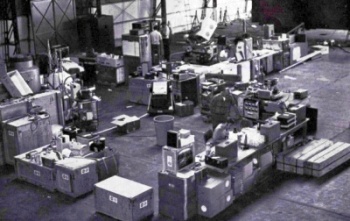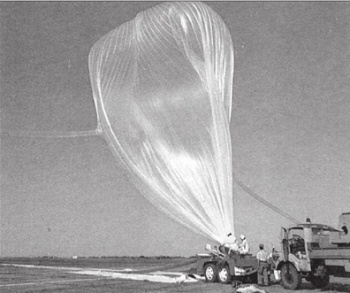The origins of this unit can be traced back to 1925 when was established the First Group of aerial observation depending then from Aviation Regiment 2 of the Argentine Army. The site of the future base was donated by people from the city of Parana to promote the development of the air force and expansion of commercial aviation, sports aviation and private transportation.
Almost immediately began the task of building the first prefabricated hangars. The new airplanes (Bristol F2-B) were received by a crowd on the morning of 14 May, 1926.
Three years later the group was reorganized, adding personnel and material coming from The Tamarindos base in Mendoza, and adopting the name of "Military Airbase General Urquiza." In 1930 other buildings were raised to serve as accommodation for staff who hitherto lived in the city of Parana. Three years later were completed the asphalt roads which linked the base with the city, fostering greater integration between the two. The impact of base's activities was large in the daily life of the city, which begins to receive many people from surrounding provinces mainly due to the new jobs generated.
Finally on March 15, 1949 with the creation of the Ministry of Aeronautics, arrives independence of the air force and the base acquires its present name as "Second Air Brigade, Parana." Since then, in the base also is located the Justo José de Urquiza airport covering only domestic flights to Buenos Aires and other provinces in the republic. Airport and military base share the same facilities.
In 1959, was established the "First Communications School Group" whose mission is to provide communications infrastructure for both fixed and mobile units of the Air Force. However, its scope is not limited to combat, but also provides support for scientific programmes of the Air Force as well serve as support for the civilian population in case of an emergency or a disaster. In that context had an outstanding participation in stratospheric balloon operations as we will mention bellow. It is worth to mention that in 1970 were received at the base the "Canberra" planes, which were assigned to the recently created "First Group of Bombing and Attack".
The "GALAXIA" program

While already existed a history of experiences with stratospheric balloons in the country, first using neoprene balloons fitted with special valves, launched from various parts of the territory and from a ship in Atlantic Ocean and two launches by NASA from Tucumán in 1964, the first complex experience involving a great volume balloon was carried out in 1969.
It took place through an agreement signed between the National Commission for Space Activities and the National Center for Atmospheric Research fronm U.S. who conducted an expedition to the country between October and November 1969 using as launch base the facilities of the Second Air Brigade. After a failed attempt a few days before (balloon damaged by strong wind gusts while in the spool) on November 26 was launched aboard a balloon 6 million cubic feet of volume, an instrument designed to make scientific observations of a new source of X radiation, discovered in July of that year by The U.S. VELA satellites. The source was located at 32° south latitude (the same latitude as the city of Parana) so the base offered the best location and infrastructure for the task.
That first successful launch marks the beginning of a national research project with stratospheric balloons that would become generically known as "Galaxia". Thus, in subsequent years, others launch campaigns were carried out from Parana transporting instruments and experiments developed by the NASA Goddard Center, the Naval Research Laboratory, the Smithsonian Observatory and universities such as Case Western Reserve, New Hampshire and Rice. During 1970 were performed 6 flights, 11 the following year and in 1973 another 8.

The launches took place during November and early December each year. As the operations were performed from the main runway of the base, was possible to use the dynamic launch technique. Once launched the balloons moved toward the west, and after a flight time of 6 to 12 hours (depending on the intensity of the winds) the payloads landed in the provinces of Cordoba and Mendoza for longer flights, and in Entre Rios or Santa Fe for the shorter ones. To track the balloons and locate the payloads in the ground were used aircraft, land vehicles and personnel belonging to the Second Air Brigade.
The radar tracking of each mission was carried out using a GMD-1 radar located in the Base, while the meteorological support was provided by personnel from the National Weather Service stationed there. All communications -including direct links with the U.S.- were carried out by the aforementioned "First Communications School Group".
In many of these missions were included as piggy back payloads, small experiments developed in Argentina, mostly related to aerial photography, because at the base operated a group of aerial reconnaisance known as the "Photographic Squadron" of the air force.
Since 1974 the "Galaxia" program acquires a certain independence and diversifies its activities in other sites including the Rio Cuarto Balloon launch base which based in Cordoba, was intended at the time to be the focal point for this activity.
We dont have accurate data after 1973 in regard of other launches. In the middle of the decade of the 80's the "Galaxia" program was over and thereafter there were very few missions in the country with stratospheric balloons. In this context the last flight which is recorded in the Second Air Brigade occurs in November 1990 with the launch of an experiment to detect cosmic rays for the Institute of Astronomy and Space Physics (IAFE). Since then, the site was not used again for balloon launches.
After the withdrawal from active service of the "Canberra" planes in 2000, the most prominent air material stationed at the base are "Fokker F-27" planes on support and logistics duties totrain personnel from an State Airline (LADE) and two "Learjet 35A" that are part of a program aimed to test radio beacons.
Table of balloons launched from Paraná
| Date | Hour | Flight Duration | Experiment | Payload landing place or cause of the failure |
|---|---|---|---|---|
| 11/26/1969 | 8:35 utc | 10 h | GAMMA RAY TELESCOPE | Near San Jorge, Santa Fe, Argentine |
| 10/22/1970 | 06:00 local | 4 h 20 m | GAMMA RAY OBSERVATION | At 31º 47' S - 58º 19' W, near the town of Ubajay, Entre Rios province |
| 11/8/1970 | 04:00 local | 2 h 15 m | GAMMASCOPE IV | At 31º 23' S - 60º 07' W, near the town of Pueblo Brugo Entre Rios province |
| 11/13/1970 | 22:50 local | 15 h | SUPERCONDUCTING MAGNET SPECTROMETER | At 31º 29' S - 67º 22' W, near the town of Marayes, San Juan province |
| 11/18/1970 | 05:15 local | 12 h 45 m | GAMMA RAY OBSERVATION | At 31º 44' S - 62º 44' W, near the town of El Arañado, Cordoba province |
| 11/25/1970 | 01:23 local | 18 h 21 m | GAMMASCOPE IV | At 33º 02' S - 66º 36' W, near the town of San Isidro, Mendoza province |
| 11/27/1970 | 23:23 local | 8 h 45 m | SUPERCONDUCTING MAGNET SPECTROMETER | At 31º 20' S - 64º 50' W, near the town of Icho Cruz, Cordoba province |
| 11/11/1971 | 7:00 local | 10 h 55 m | GAMMA RAY AND NEUTRON MEASUREMENTS | Near Piquillin, Cordoba, Argentine |
| 11/15/1971 | --- | GAMMA RAY TELESCOPE | Ground abort. Inflation tube detached from balloon during inflation | |
| 11/16/1971 | 6:45 local | 9 h 55 m | GAMMA RAY TELESCOPE | Near San Carlos, Santa Fe, Argentine |
| 11/20/1971 | 6:30 local | 9 h 50 m | LOW ENERGY GAMMA RAY TELESCOPE | Near Monte Ralo, Cordoba, Argentine |
| 11/22/1971 | 6:15 local | 11 h 25 m | GAMMA RAY AND NEUTRON MEASUREMENTS + PHOTOGRAPHIC EXPERIMENT | Near Almafuerte, Cordoba, Argentine |
| 11/23/1971 | 5:45 local | 11 h 35 m | ATMOSPHERIC NEUTRONS MEASUREMENTS | Near Calchin, Cordoba, Argentine |
| 11/25/1971 | 6:25 local | 9 h 55 m | LOW ENERGY GAS CERENKOV DETECTOR | Near La Paz, Mendoza, Argentine |
| 11/27/1971 | --- | FAR INFRARED TELESCOPE | Balloon Failure | |
| 11/29/1971 | 19:58 local | F 6 h 45 m | FAR INFRARED TELESCOPE | Near Las Varillas, Cordoba, Argentine |
| 12/1/1971 | 6:50 local | 11 h 10 m | GAMMA RAY TELESCOPE + PHOTOGRAPHIC CAMERA | Near Agua de Oro, Cordoba, Argentine |
| 12/5/1971 | 6:55 local | 10 h | LOW ENERGY GAS CERENKOV DETECTOR | Near Milagro, La Rioja, Argentine |
| 12/6/1971 | 19:26 local | 11 h 19 m | FAR INFRARED TELESCOPE | Near Jesus Maria, Cordoba, Argentine |
| 12/10/1971 | 6:11 local | 8 h 10 m | ATMOSPHERIC NEUTRONS MEASUREMENTS | Near Salsacate, Cordoba, Argentine |
| 11/6/1973 | 6:35 local | 1 h | WHOLE AIR SAMPLER + PHOTOGRAPHIC CAMERA | Near Bovril, Entre Rios, Argentina |
| 11/14/1973 | 6:20 local | 7 h | WHOLE AIR SAMPLER + PHOTOGRAPHIC CAMERA | Near Montiel, Entre Rios, Argentina |
| 11/15/1973 | 18:20 local | F 10 h 25 m | OBSERVATIONS OF INFRARED ASTRONOMICAL SOURCES | Near Basavilbaso, Entre Rios, Argentine |
| 11/18/1973 | 6:00 local | 8 h | SPECTRUM AND INTENSITY OF GAMMA RADIATION + SOLAR POINTER + PHOTOGRAPHIC CAMERA | --- No Data --- |
| 11/20/1973 | 18:55 local | 6 h | OBSERVATIONS OF INFRARED ASTRONOMICAL SOURCES | --- No Data --- |
| 11/25/1973 | 6:30 local | ~ 10 h | NEUTRON DETECTOR + PHOTOGRAPHIC CAMERA | In Las Varas, Cordoba, Argentine |
| 12/1/1973 | --- | OBSERVATIONS OF INFRARED ASTRONOMICAL SOURCES | --- No Data --- | |
| 12/8/1973 | F 10 h 20 m | OBSERVATIONS OF INFRARED ASTRONOMICAL SOURCES | --- No Data --- | |
| 11/18/1990 | --- | PLASTIC SCINTILLATOR | --- No Data --- |
If you consider this website interesting or useful, you can help me to keep it up and running with a small donation to cover the operational costs. Just the equivalent of the price of a cup of coffee helps a lot.

